2023届高考英语二轮复习 语法之代词&介词课件 (24张ppt)
文档属性
| 名称 | 2023届高考英语二轮复习 语法之代词&介词课件 (24张ppt) |  | |
| 格式 | pptx | ||
| 文件大小 | 5.5MB | ||
| 资源类型 | 教案 | ||
| 版本资源 | 通用版 | ||
| 科目 | 英语 | ||
| 更新时间 | 2022-09-21 12:47:54 | ||
图片预览


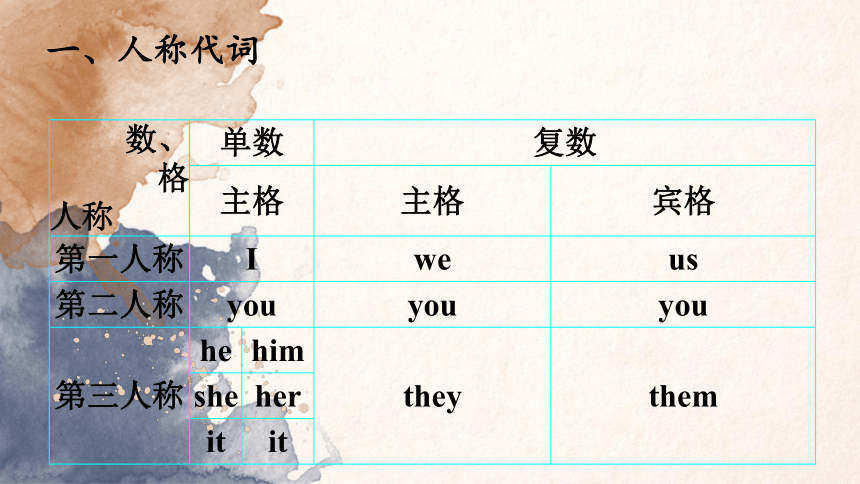


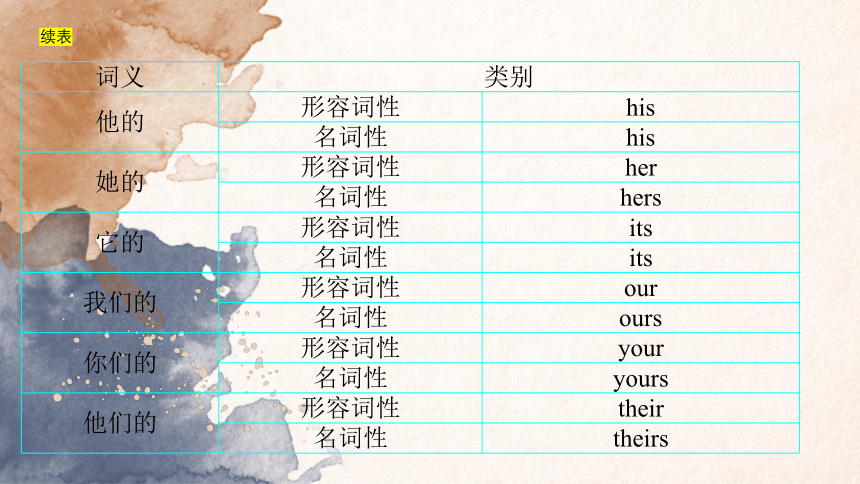
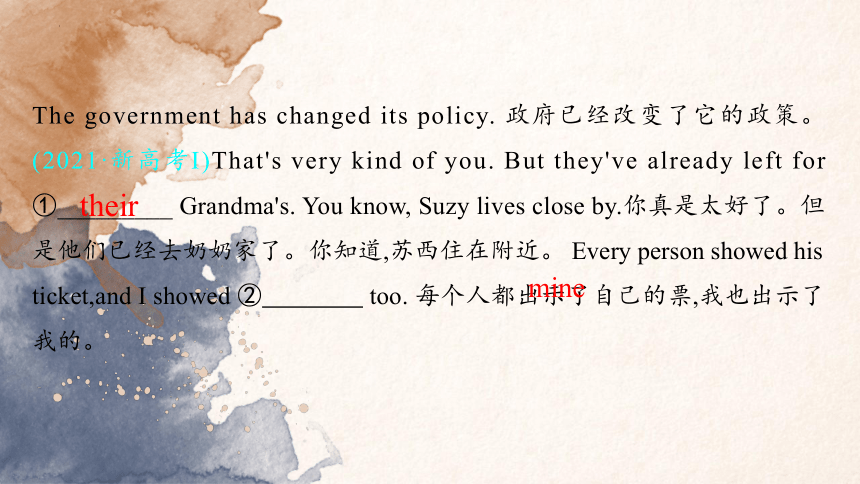
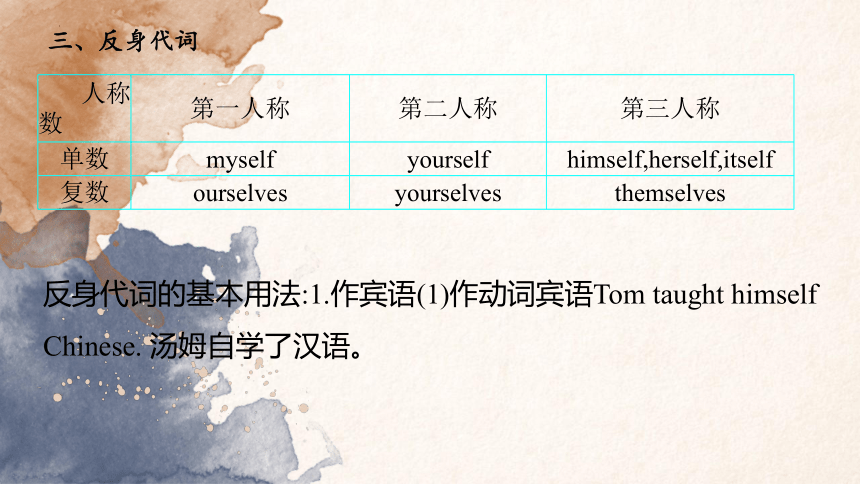
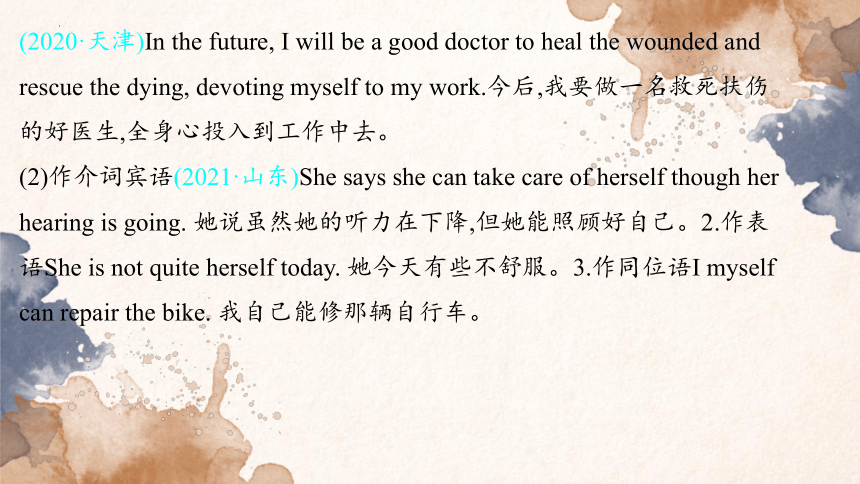
文档简介
(共24张PPT)
高中英语语法---代词&介词
一、代词
一、人称代词
数、格 人称 单数 复数 主格 主格 宾格
第一人称 I we us
第二人称 you you you
第三人称 he him they them
she her it it Thank you for your letter. 谢谢你的来信。I bought a present for him. 我给他买了一份礼物。(2021·全国甲)If possible, you can reply to me as soon as possible. I will take your advice into consideration. 如果可能的话,你可以尽快回复我。我会考虑你的建议。
二、物主代词
词义 类别 我的 形容词性 my
名词性 mine
你的 形容词性 your
名词性 yours
续表
词义 类别 他的 形容词性 his
名词性 his
她的 形容词性 her
名词性 hers
它的 形容词性 its
名词性 its
我们的 形容词性 our
名词性 ours
你们的 形容词性 your
名词性 yours
他们的 形容词性 their
名词性 theirs
The government has changed its policy. 政府已经改变了它的政策。(2021·新高考Ⅰ)That's very kind of you. But they've already left for ①_________ Grandma's. You know, Suzy lives close by.你真是太好了。但是他们已经去奶奶家了。你知道,苏西住在附近。 Every person showed his ticket,and I showed ② too. 每个人都出示了自己的票,我也出示了我的。
their
mine
三、反身代词
人称 数 第一人称 第二人称 第三人称
单数 myself yourself himself,herself,itself
复数 ourselves yourselves themselves
反身代词的基本用法:1.作宾语(1)作动词宾语Tom taught himself Chinese. 汤姆自学了汉语。
(2020·天津)In the future, I will be a good doctor to heal the wounded and rescue the dying, devoting myself to my work.今后,我要做一名救死扶伤的好医生,全身心投入到工作中去。
(2)作介词宾语(2021·山东)She says she can take care of herself though her hearing is going. 她说虽然她的听力在下降,但她能照顾好自己。2.作表语She is not quite herself today. 她今天有些不舒服。3.作同位语I myself can repair the bike. 我自己能修那辆自行车。
四、不定代词
1.both、all、either、any、neither以及none之间的区别
词义 指代 都 任何一个 都不
两个人或物 both either neither
三个或三个以上的人或物 all any none
Equally important, I am fluent in ① Chinese and English, so I have no difficulty in communicating with others.同样重要的是,我的中文和英文都很流利,所以我与他人交流没有困难。 (2021·天津第一次)② of them chose the moment that had transformed them. 他们两人都没有选择已经改变了他们的时刻。
both
Neither
关键词
关键词
关键词
2.one、another、the other、some、others以及the others之间的区别
单数 one(一个) another(另外一个) the other(另一个)
复数 some(一些) others(另外一些) the others(其余)
I have two books:one is English,and ③ is French. 我有两本书:一本是英语书,另一本是法语书。 There are many books on the table:④ are English, and the others are French. 桌子上有很多书:一些是英语书,剩下的是法语书。 If not, take ⑤ look at other methods you could try. 如果没有,再看看你可以尝试的其他方法。
the other
some
another
关键词
关键词
关键词
3.none、nobody/no one、nothing之间的区别
none 指代人或物 用来回答How many... / How much... 相当于not a/an/any+名词或no+名词
nobody/no one 指代人 用来回答Who... 相当于not anyone/anybody
nothing 指代物 用来回答What... 相当于not anything
—How much money do you have 你有多少钱 —None. 一点也没有。If I had some money,I would lend him some,but unfortunately,I have none. 如果我有钱,我就借给他了,但遗憾的是,我没钱。I wished someone could help me,but there was no one at the moment. 我希望有人能帮帮我,但当时没有人帮我。
关键词
关键词
关键词
4.many、much、few、little、a few以及a little之间的区别
词义 指代 多 少 (有)一些 几乎没有
复数名词 many few a few few
不可数名词 much little a little little
(2021·全国甲)Some will turn out to their parents or teachers for help. Only ⑥_______ choose to deal with the problems on their own. 有些人会向他们的父母或老师求助。只有一小部分人选择自己解决问题。
a few
关键词
关键词
关键词
5.one、ones、the one、the ones、that以及those之间的区别
one 替代“a/an+单数名词”
ones 替代“零冠词+复数名词”
the one 替代“the+单数名词”
the ones 替代“the+复数名词”
that 替代“the+单数名词或不可数名词”(尤其是有后置定语时)
those 替代“the+复数名词”(尤其是有后置定语时)
We have various summer camps for your holidays. You can choose one (=a summer camp) based on your own interests. 我们为您的假期提供了各种各样的夏令营,您可以根据自己的兴趣选择一种。(2021·新高考Ⅰ)This was the sort of work that made you appreciate the dollars you earned and respect those who did the work, he told me.他告诉我,这种工作能让你感激自己挣来的钱,尊重那些从事这项工作的人。
关键词
关键词
关键词
二、介词
关键词
关键词
关键词
1.表示方位的at、in、on、to、beside/by和near
介词 用法
at 一般指在较小的地方
in 一般指在较大的地方或在某一范围内
on 一般指在物体的表面或相邻并接壤的两个地域
to 表示某范围外不接壤的两个位置
beside/by 表示“在……的旁边”
near 表示“接近;靠近”
关键词
关键词
关键词
Shandong Province lies in the east of China. 山东省位于中国东部。The picture is hanging on the wall. 这幅画挂在墙上。Jiangsu Province is to the southeast of Hebei Province. 江苏省在河北省的东南部。She was standing beside her mother. 她站在她母亲旁边。There is a supermarket near my home. 我家附近有一家超市。
关键词
关键词
关键词
2.表示方位的between 和among
介词 用法
between 在两者或每两者之间
among 在三者或三者以上之中
(2020·江苏)Documentaries about China, produced either in China or in other countries, are becoming increasingly popular among foreigners.在中国或其他国家制作的中国纪录片在外国人中越来越受欢迎。(2021·浙江1月)But 30 years later, the BMI difference between urban and rural people in many countries had narrowed sharply.但是30年后,许多国家的城市和农村人口的身体质量指数差异大幅缩小。
关键词
关键词
关键词
3.表示方位的across、through、over和past
介词 用法
across 从……的表面穿过
through 从……的内部穿过
over 从……的上面跨过
past 从……的旁边经过
He walked across the square to meet us. 他走过广场来迎接我们。The thief jumped over the fence and fled away. 小偷跳过篱笆逃走了。
关键词
关键词
关键词
4.表示时间点的at、in和on
介词 用法 示例
at 表示在某个时间点、时刻或重大节日 at 9:00;at noon;at daybreak;at Christmas
in 表示在某个较长的时间段内,如世纪、朝代或年月;泛指的上午、下午、傍晚 in the 21st century;in September;in the morning
on 表示在具体某一天或具体某一天的上午、下午、晚上 on 2nd,September;on the morning of 1st,May
关键词
关键词
关键词
5.表示时间段的for和 since
介词 用法
for “for+时间段”意为“多长时间”,表示动作持续的时间长短,一般作完成时、过去时或将来时的时间状语
since “since+时间点”意为“自从(过去某时)以来”,一般作完成时的时间状语
He has lived in the small village ① five years. 他在这个小村庄里住了五年。 He has worked in this company ② graduation. 他毕业后一直在这家公司工作。
for
since
6.表示交通方式的by、in和on
介词 用法
by “by+名词”表示交通方式时,名词前不加冠词
in/on in/on后的名词必须有冠词或代词等修饰
My brother usually goes to school ③ bike. 我的哥哥通常骑自行车上学。 My father often goes to work ④ his car or on his bicycle. 我的爸爸经常开车或者骑自行车去上班。
by
in
7.表示“用……”的by、in和with
介词 用法
by 指“靠……手段;用……方法;凭借……”,后可接名词、代词或动名词
in 多用于表示语言、材料的名词前
with 多用于表示有形的工具或身体器官的名词前
He made a living by selling newspapers when he was young. 他年轻时靠卖报纸为生。All the applicants are required to fill in the form in ink. 所有申请者都必须用钢笔填写表格。They are busy digging with spades. 他们正忙着用铲子挖掘。
高中英语语法---代词&介词
一、代词
一、人称代词
数、格 人称 单数 复数 主格 主格 宾格
第一人称 I we us
第二人称 you you you
第三人称 he him they them
she her it it Thank you for your letter. 谢谢你的来信。I bought a present for him. 我给他买了一份礼物。(2021·全国甲)If possible, you can reply to me as soon as possible. I will take your advice into consideration. 如果可能的话,你可以尽快回复我。我会考虑你的建议。
二、物主代词
词义 类别 我的 形容词性 my
名词性 mine
你的 形容词性 your
名词性 yours
续表
词义 类别 他的 形容词性 his
名词性 his
她的 形容词性 her
名词性 hers
它的 形容词性 its
名词性 its
我们的 形容词性 our
名词性 ours
你们的 形容词性 your
名词性 yours
他们的 形容词性 their
名词性 theirs
The government has changed its policy. 政府已经改变了它的政策。(2021·新高考Ⅰ)That's very kind of you. But they've already left for ①_________ Grandma's. You know, Suzy lives close by.你真是太好了。但是他们已经去奶奶家了。你知道,苏西住在附近。 Every person showed his ticket,and I showed ② too. 每个人都出示了自己的票,我也出示了我的。
their
mine
三、反身代词
人称 数 第一人称 第二人称 第三人称
单数 myself yourself himself,herself,itself
复数 ourselves yourselves themselves
反身代词的基本用法:1.作宾语(1)作动词宾语Tom taught himself Chinese. 汤姆自学了汉语。
(2020·天津)In the future, I will be a good doctor to heal the wounded and rescue the dying, devoting myself to my work.今后,我要做一名救死扶伤的好医生,全身心投入到工作中去。
(2)作介词宾语(2021·山东)She says she can take care of herself though her hearing is going. 她说虽然她的听力在下降,但她能照顾好自己。2.作表语She is not quite herself today. 她今天有些不舒服。3.作同位语I myself can repair the bike. 我自己能修那辆自行车。
四、不定代词
1.both、all、either、any、neither以及none之间的区别
词义 指代 都 任何一个 都不
两个人或物 both either neither
三个或三个以上的人或物 all any none
Equally important, I am fluent in ① Chinese and English, so I have no difficulty in communicating with others.同样重要的是,我的中文和英文都很流利,所以我与他人交流没有困难。 (2021·天津第一次)② of them chose the moment that had transformed them. 他们两人都没有选择已经改变了他们的时刻。
both
Neither
关键词
关键词
关键词
2.one、another、the other、some、others以及the others之间的区别
单数 one(一个) another(另外一个) the other(另一个)
复数 some(一些) others(另外一些) the others(其余)
I have two books:one is English,and ③ is French. 我有两本书:一本是英语书,另一本是法语书。 There are many books on the table:④ are English, and the others are French. 桌子上有很多书:一些是英语书,剩下的是法语书。 If not, take ⑤ look at other methods you could try. 如果没有,再看看你可以尝试的其他方法。
the other
some
another
关键词
关键词
关键词
3.none、nobody/no one、nothing之间的区别
none 指代人或物 用来回答How many... / How much... 相当于not a/an/any+名词或no+名词
nobody/no one 指代人 用来回答Who... 相当于not anyone/anybody
nothing 指代物 用来回答What... 相当于not anything
—How much money do you have 你有多少钱 —None. 一点也没有。If I had some money,I would lend him some,but unfortunately,I have none. 如果我有钱,我就借给他了,但遗憾的是,我没钱。I wished someone could help me,but there was no one at the moment. 我希望有人能帮帮我,但当时没有人帮我。
关键词
关键词
关键词
4.many、much、few、little、a few以及a little之间的区别
词义 指代 多 少 (有)一些 几乎没有
复数名词 many few a few few
不可数名词 much little a little little
(2021·全国甲)Some will turn out to their parents or teachers for help. Only ⑥_______ choose to deal with the problems on their own. 有些人会向他们的父母或老师求助。只有一小部分人选择自己解决问题。
a few
关键词
关键词
关键词
5.one、ones、the one、the ones、that以及those之间的区别
one 替代“a/an+单数名词”
ones 替代“零冠词+复数名词”
the one 替代“the+单数名词”
the ones 替代“the+复数名词”
that 替代“the+单数名词或不可数名词”(尤其是有后置定语时)
those 替代“the+复数名词”(尤其是有后置定语时)
We have various summer camps for your holidays. You can choose one (=a summer camp) based on your own interests. 我们为您的假期提供了各种各样的夏令营,您可以根据自己的兴趣选择一种。(2021·新高考Ⅰ)This was the sort of work that made you appreciate the dollars you earned and respect those who did the work, he told me.他告诉我,这种工作能让你感激自己挣来的钱,尊重那些从事这项工作的人。
关键词
关键词
关键词
二、介词
关键词
关键词
关键词
1.表示方位的at、in、on、to、beside/by和near
介词 用法
at 一般指在较小的地方
in 一般指在较大的地方或在某一范围内
on 一般指在物体的表面或相邻并接壤的两个地域
to 表示某范围外不接壤的两个位置
beside/by 表示“在……的旁边”
near 表示“接近;靠近”
关键词
关键词
关键词
Shandong Province lies in the east of China. 山东省位于中国东部。The picture is hanging on the wall. 这幅画挂在墙上。Jiangsu Province is to the southeast of Hebei Province. 江苏省在河北省的东南部。She was standing beside her mother. 她站在她母亲旁边。There is a supermarket near my home. 我家附近有一家超市。
关键词
关键词
关键词
2.表示方位的between 和among
介词 用法
between 在两者或每两者之间
among 在三者或三者以上之中
(2020·江苏)Documentaries about China, produced either in China or in other countries, are becoming increasingly popular among foreigners.在中国或其他国家制作的中国纪录片在外国人中越来越受欢迎。(2021·浙江1月)But 30 years later, the BMI difference between urban and rural people in many countries had narrowed sharply.但是30年后,许多国家的城市和农村人口的身体质量指数差异大幅缩小。
关键词
关键词
关键词
3.表示方位的across、through、over和past
介词 用法
across 从……的表面穿过
through 从……的内部穿过
over 从……的上面跨过
past 从……的旁边经过
He walked across the square to meet us. 他走过广场来迎接我们。The thief jumped over the fence and fled away. 小偷跳过篱笆逃走了。
关键词
关键词
关键词
4.表示时间点的at、in和on
介词 用法 示例
at 表示在某个时间点、时刻或重大节日 at 9:00;at noon;at daybreak;at Christmas
in 表示在某个较长的时间段内,如世纪、朝代或年月;泛指的上午、下午、傍晚 in the 21st century;in September;in the morning
on 表示在具体某一天或具体某一天的上午、下午、晚上 on 2nd,September;on the morning of 1st,May
关键词
关键词
关键词
5.表示时间段的for和 since
介词 用法
for “for+时间段”意为“多长时间”,表示动作持续的时间长短,一般作完成时、过去时或将来时的时间状语
since “since+时间点”意为“自从(过去某时)以来”,一般作完成时的时间状语
He has lived in the small village ① five years. 他在这个小村庄里住了五年。 He has worked in this company ② graduation. 他毕业后一直在这家公司工作。
for
since
6.表示交通方式的by、in和on
介词 用法
by “by+名词”表示交通方式时,名词前不加冠词
in/on in/on后的名词必须有冠词或代词等修饰
My brother usually goes to school ③ bike. 我的哥哥通常骑自行车上学。 My father often goes to work ④ his car or on his bicycle. 我的爸爸经常开车或者骑自行车去上班。
by
in
7.表示“用……”的by、in和with
介词 用法
by 指“靠……手段;用……方法;凭借……”,后可接名词、代词或动名词
in 多用于表示语言、材料的名词前
with 多用于表示有形的工具或身体器官的名词前
He made a living by selling newspapers when he was young. 他年轻时靠卖报纸为生。All the applicants are required to fill in the form in ink. 所有申请者都必须用钢笔填写表格。They are busy digging with spades. 他们正忙着用铲子挖掘。
